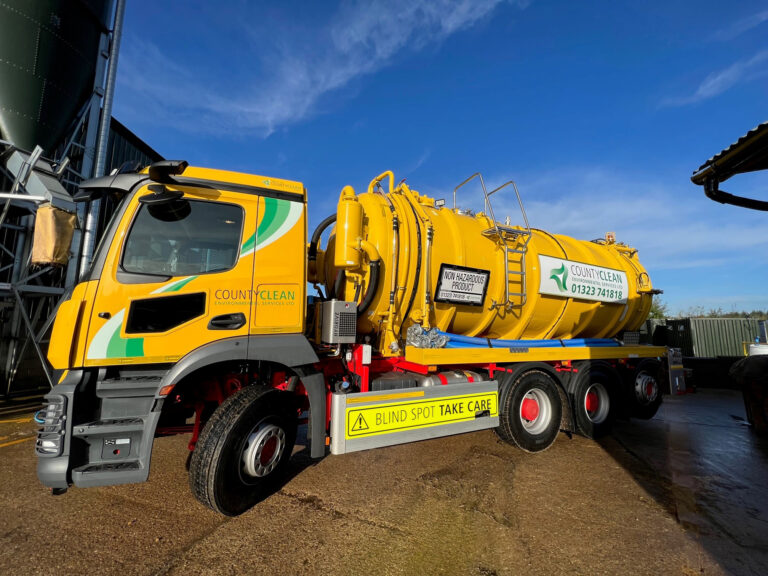Road Safety Week
Road Safety Week is the largest road safety initiative in the UK, introduced by Brake is an annual event that aims to raise awareness about the importance of safe road usage and the prevention of accidents. This year it takes place from 19th – 25th November.
It’s reported that every day, five people die on UK roads. The campaign’s #Brake5 initiative is to remember road victims and generate donations for Brake to aid their vital work in caring families affected by road accidents.
At County Clean Group, we believe that a safe road is a shared responsibility. In this blog post, we’ll explore some essential tips for staying safe on the road when driving near HGVs.
Highway Code Changes
As of January 2022, the Highway Code implemented significant updates, introducing several new rules aimed at enhancing road safety. Among these changes is the introduction of a new hierarchy of road users, emphasising that those with the potential to cause the most harm, bear the greatest responsibility to reduce the danger or threat they may pose to others on the road.
This innovative approach to road safety highlights the principle that individuals operating powerful vehicles with the capabilities to cause significant harm must exercise heightened caution and take proactive measures to minimise risks. This approach promotes a safer, more considerate road environment and encourages a shared responsibility among all road users.

Visibility Zones
Understanding their limited visibility zones, braking distances, and unique challenges from the driver’s perspective can help make our roads safer for everyone.
HGVs have restricted vision on all sides of the vehicle. To ensure your safety, avoid lingering in these zones. If you find yourself behind a HGV, maintain a safe distance to ensure you can see the road ahead.
Front Zone
When driving in front of an HGV, remember HGV drivers sit high up. To ensure they can see you and have sufficient space to brake safely, maintain an appropriate distance between your vehicle and the HGV.
Left Zone
The Highway Code strongly advises against overtaking on the left or moving into the left lane for overtaking. However, if you happen to find yourself in the left lane with an HGV to your right, make a safe manoeuvre to get out of the limited visibility zone as soon as safely possible, as the driver might not see you.
Right Zone
When overtaking a HGV, overtake with care. Ensure that you have enough space ahead of them to complete the manoeuvre. Remember that passing a large vehicle takes more time, so avoid lingering and ensure there is enough space to merge back into the HGV driver’s field of vision.
Rear Zone
If you are driving too close behind a HGV, you will not be seen by the driver and you will not be able to see the road ahead of you. As a general rule, if you cannot see the HGV’s external mirrors or cameras, the driver cannot see you. Ensure your visible to the driver by pulling back to a distance where you can be seen, ideally up to 3 car lengths.
Driver Training and Audits
Road haulage is essential for keeping the UK economy and supply chains moving, involving over 406,000 Heavy Goods Vehicles (HGVs) across the roads in Great Britain. The industry is subject to very strict regulations and actively advocates road safety compliance.
As a large fleet operating company, we monitor and promote all our professional drivers to maintain the highest safety standards.
CountyClean Group is committed to protecting our employee’s health and keeping them safe at work. The drivers and operators are the foundation of our company, playing a vital role in our day-to-day operations. Ensuring their safety while driving is our primary concern.
We take pride in our team of highly experienced and qualified drivers and operators who, on a daily basis, skilfully navigate the challenges of driving a HGV.
All our operatives attend the relevant training and safety courses specific to the industry as well as their role, with new drivers receiving a thorough induction and extensive training before operating any of our vehicles. A number of our drivers handle hazardous materials that present potential risks to both people’s well-being and the environment. Therefore, they undergo routine ADR training to ensure proper handling and compliance.
All our drivers are regularly audited and given a score of a 100. This score is calculated based on their driving behaviour including; speeding, harsh breaking and acceleration. This is consistently monitored and reviewed.
Vehicle Safety
The latest technology and working practises are incorporated to meet the demands of the highly regulated waste industry. All of the Group’s vehicles are equipped with CCTV cameras in the cabs and on the exterior of the vehicles.
All CountyClean Group’s HGVs are also equipped with the following:
- Tracking system
- Blind spot mirrors and cameras
- Reversing alarms
- Flashing beacons
Before leaving the premises, every operative is required to go through a comprehensive checklist for their vehicles. No vehicle is driven until any defects identified have been resolved.

Transport for London (TfL) have announced from October 2024, HGVs over 12 tonnes will be required to have a three-star rating or fit vehicles with a range of safety systems to be permitted to operate in Greater London. At CountyClean Group, we welcome and embrace these upgrades as it will allow more visibility for our drivers to see potential pedestrians and cyclists in their blind spots. Our 3 latest tankers that joined our fleet this year, all have an additional window fitted in the passenger side door to allow better view to anything in the left limited visibility zone.
We hope that this information has proven helpful to drivers, cyclists and pedestrians, shedding light on the blind spots of heavy goods vehicles. It is our aim to raise awareness of the daily challenges faced by HGV drivers and the associated hazards.
